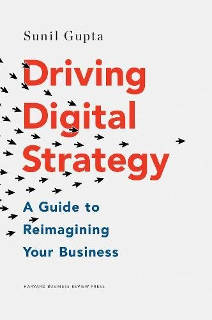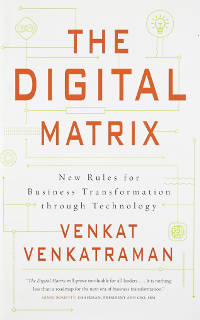[Image by Gerd Altmann from Pixabay]
Early this year, I was invited to address the strategy retreat of one of India’s leading banks. With the aim of diversifying the inputs available, the bank had invited representatives of several leading consulting firms as well. What became clear after a few hours there was that banking has reached an inflection point. The words “digital,” “disruption,” and “data” dominated every presentation and discussion. There was broad agreement that only regulation prevented the industry from getting over-turned. And, that the biggest threat to banking as we know it is from the digital giants (like Amazon, Facebook, Google and Alibaba). Existing banks do have a valuable network of customers, but the digital giants have much larger and stickier networks, know much more about their members, and have the tools to use such data to their advantage.
Existing strategy frameworks…
This experience made me re-think strategy and how it should be formulated and taught. I have been teaching “Strategic Management” as it is formally called for over 20 years. Though the business world has gone through major changes over this period, the broad contours of the core course on this subject that we teach in business schools have remained largely the same: Understanding the importance of vision and mission; mapping the forces influencing competition in the industry using Michael Porter’s well-known “5 Forces” framework; competitive positioning and generic strategies; identification and analysis of the resources and capabilities that underlie strategy; and strategy implementation have been essential elements of business-level strategy.
… and how they came into question
For quite some years, this framework worked quite well to both explain and formulate business-level strategy. It first came into question around the turn of the millennium when the internet made its presence felt. Explaining the pioneering moves by companies like Charles Schwab, influential works written at that time such as Blown to Bits argued that Internet-based businesses could overcome the trade-offs between richness and reach, thereby making irrelevant and unnecessary some of the strategic choices that the generic strategies framework implied. Other commentators argued that the emphasis of the 5 Forces model on entry barriers that would protect incumbents’ profitability was no longer valid as the internet had removed barriers to entry in many industries and made diversification across borders easy.
Porter’s response
Michael Porter came back strongly with a detailed (and unusually long) defence of his model in an article titled ‘Strategy and the Internet’ in Harvard Business Review. His main argument was that the basic strategy framework and competitive forces had not changed, and all that was required was to see how the internet had affected the relative strength of the five competitive forces he had identified earlier. Others said that the argument regarding the irrelevance of the richness-reach trade-off applied only to those businesses which could become completely internet-based like financial services. In other words, internet-based businesses could be considered a special case of existing business strategy frameworks.
India and the internet
Of course, here In India, we experienced a dotcom boom in terms of many new enterprises being created, but few dotcom businesses sustained. This was primarily because of the poor penetration of broadband internet. Existing businesses faced little difficulty in integrating the internet as just another channel or as a tool to facilitate logistics. We didn’t witness dramatic business events like the collapse of Tower Records or a confrontation of the Amazon vs Barnes & Noble which would bring fundamental concepts into question.
The internet as a force for strategic change in India had to wait till at least 2010 for the advent of 3G telecom services and the widespread use of the smartphone to access the internet. This trend further intensified with the launch of Reliance Jio’s 4G services in 2016.
New technologies give digitalisation a tailwind
In the meantime, across the world the advent of new technologies meant that the impact of digitalisation was going beyond those industries in which the product itself could be delivered digitally (such as books, music, movies, and financial services). RFID tags and the Internet of Things (IoT) made it possible for physical products to become digitally-enabled. Machine learning and advanced data analysis allowed greater pattern-finding, optimisation and customisation. The combination of these forces made disruption of existing business models easier. Born-digital businesses looked at delivering business value in very different ways from existing businesses.
Today, it is trite to say that digital has transformed industries. It’s certainly true that incumbent companies are worried about where the next disruptor will come from. But there is an increasing consensus that for incumbents the most potent competitor is not the next startup, but one of the established digital giants, either on its own or through the acquisition of disruptive startups.
Do we need new frameworks and tools?
Which brings us back to the earlier question: are the existing concepts, tools and frameworks adequate to formulate strategy in the digital era?
At a high level of abstraction, the answer is perhaps yes. Major changes like digital disruption can be explained and addressed by using the existing frameworks in conjunction with ideas on industry transformation to bring in a dynamic element. But what about in practice?
What do the best books on digital transformation and strategy say?
In the last few months, I read several books on digital transformation to investigate how contemporary scholars of this phenomenon address important strategy questions. In this article I draw on the three most relevant ones.
“In today’s connected world, sustainable competitive advantage comes from offering a system of connected and complementary products, and from creating a platform with strong network effects that increase consumers’ switching costs.”

Not surprisingly, Sunil Gupta, a professor at Harvard Business School, is the one who addresses strategy issues head-on in Driving Digital Strategy. He points to the declining relevance of the generic strategies framework by arguing that the strengths that enable Amazon’s success are all unrelated to the resources that typically underlie a cost leadership or differentiation strategy. He argues that strategy for digital giants is more about developing new resources and capabilities to meet the evolving needs of members of their existing digital networks than leveraging existing resources as diversification theory would suggest.
Watch Prof Sunil Gupta speak on Driving Digital Strategy:
“Today we are at an inflection point where old definitions of industries, competition, and organisations do not make much sense, but we do not yet have new ways to define and demarcate pockets of value created by digital technologies.”

By getting granular on the stage of the transformation process a particular industry has reached, Boston University’s Venkat Venkatraman advocates looking at strategy in three buckets depending on how far digital has progressed in a particular industry—is digital transformation still at the periphery? Or has it reached the core? Or is it striking at the roots? Venkatraman’s model divides business entities into three categories as well—digital giants, large incumbents and tech startups, thus ending up with a 3 X 3 “digital matrix” (which, incidentally, is the name of his book).
Venkatraman’s book is strongest at looking at the challenges faced by incumbents. He draws attention to how some basic assumptions of business have changed—from specialisation, standardisation and economies of scale to networks, network economy effects and winners-take-all. His book has a powerful framework that helps an incumbent figure out when it needs to respond to digital transformation and how it should do so. The importance of such an approach is underlined in my mind through a thought-provoking case study of how a startup called Nest developed an intelligent thermostat that challenged Honeywell’s strong thermostat franchise once it (Nest) was acquired by Google. This eventually became one of the core pieces of Google’s Home automation business.
Watch Venkatraman speak on the digital matrix in healthcare:
“To adapt and thrive in the digital age, businesses must learn to view customers differently, understanding the dynamic, networked ways in which they interact, now both with customers and with each other.”

In The Digital Transformation Playbook, Columbia Business School’s David Rogers contrasts strategy in the digital era to prior approaches to strategy. Like Venkatraman, the core of his argument is that the major assumptions underlying strategy have changed. Companies no longer need to take strategic bets and then just hope for the best—low-cost strategy experiments are not only possible but the way to go. It is not unusual for companies to both collaborate and compete with each other.
Rogers adds two useful tools to the strategist’s toolkit—the competitive value train (which takes an ecosystem view of value creation and appropriation), and the value proposition roadmap (to shape the value proposition for customers). In the digital era, Rogers explains how the most effective strategy is a platform-based approach which enjoys the combination of powerful network effects and a whole range of complements (think Amazon, Tencent).
It is worth remembering here that Porter did not pay much attention to complements in his original formulation of competitive strategy, and it took the influential work of Barry Nalebuff and Adam Brandenburger in the mid-1990s to give complements the importance they deserved—so much so that they are now often regarded as the sixth force to be added to Porter’s original five forces.
Rogers implicitly draws attention to an important feature of the network economy that we know intuitively—power remains important! Through his emphasis on the bargaining power of suppliers and buyers, Porter argued forty years ago that strategy translates into superior financial performance when a company has the power to appropriate value from a value chain. Rogers extends this power perspective to the digital network economy, pointing out that superior value accrues to those entities which control the ends of the chain or to the entity in the chain which creates unique value.
Watch David Rogers speak on The Digital Transformation Playbook
Among the books I read, Rogers has the best coverage of the core concepts related to platforms including clear definitions and a comprehensive exposition of the all-important area of multi-sided networks and network effects.
Conclusion and takeaways
So, what’s the bottom-line? In my view, to make good strategic decisions in the digital era, particularly during this transition phase, we need three lenses. The first lens is an understanding of microeconomics. Though I didn’t explicitly discuss microeconomics here, the basic concepts of competitive strategy are grounded in microeconomics, and it’s helpful to start with the fundamentals!
The second lens is the basic strategy toolkit which we have used in strategy courses for decades. Much of it is still relevant, though it’s at one level higher than what is ideal for the immediate challenge of creating a digital strategy.
And, the third lens integrates the frameworks and perspectives of Sunil Gupta, Venkat Venkatraman and David Rogers in their recent books so that you can make digital strategy work.
Applying these frameworks would imply that the bank I mentioned at the beginning of this article would need to strengthen and reinforce its customer network digitally; create new resources and capabilities as well as partner with other organisations to meet the needs of this network better, perhaps even going beyond banking to other complementary services; and work on creating greater stickiness with the final customer as power is at the ends.
[I acknowledge with thanks useful inputs from my Strategy area colleagues at IIM Bangalore during a recent area meeting.]
Dig Deeper
1. Understanding Digital Strategy: A podcast with Sunil Gupta (Play time: 26:35 mins)
2. The Digital Matrix: A talk by N Venkatraman (Play time: 1:16 hours)
3. Create your Digital Transformation Playbook by David Rogers (Play time: 56:58 mins)
Bibliography
Michael E. Porter Competitive Strategy: Techniques for Analyzing Industries and Competitors.
Adam M. Brandenburger and Barry J. Nalebuff Co-Opetition.
Philip Evans and Thomas S. Wurster Blown to Bits: How the New Economics of Information Transforms Strategy.
David L. Rogers The Digital Transformation Playbook.
Venkat Venkatraman The Digital Matrix: New Rules for Business Transformation through Technology.
Sunil Gupta Driving Digital Strategy: A Guide to Reimagining Your Business.


